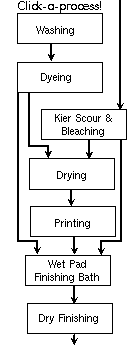

| PROCESS | INPUTS | WASTES | ||||
|---|---|---|---|---|---|---|
| Raw materials | Water | Energy | Liquid | Solid | Gas | |
| Knit Greige Goods Detergents | N.A. (10) | (2) | N.A (1) | |||
| Dyes, auxiliaries See Tables 9,10 | See Table 8 (1) | 42.7 GJ [22] (2)(3) | Highly variable (1) | Vapours | ||
| Scour Agents Bleach Agents | N.A. (1) | (2) | N.A. (1) | |||
| (2) | Vapours Particulate | |||||
| See Tables 9,10,11 | N.A. (1) | (2) | N.A. (1) | VOC See Table 9 | ||
| Finishing Agent | N.A. (1) | (2) | Vapours Particulate | |||
| N.A. | (2) | Vapors Particulate | ||||
(1) Tables 5.1 and 5.2 show the amount of water typically used and the waste load of a Knit Fabric Finishing Mill.
(2) The energy consumption for knitted Fabric Finishing is, according to reference [14], 20,700 kWh per tonne of finished knit fabric.
(3) Energy required for combined disperse/reactive dyeing of polyester/cotton knit fabric.
| Process Description | Minimum | Median | Maximum |
|---|---|---|---|
| Simple | 8.3 | 135.9 | 392.8 |
| Complex | 20.0 | 83.4 | 377.8 |
| Hosiery Products | 5.8 | 69.2 | 289.4 |
| Units | Type of Process | BOD | COD | TSS | O&G | Phenol | Cr | Sulphide |
|---|---|---|---|---|---|---|---|---|
| mg/l | Not specified | 350 | 1000 | 300 | 53 | 0.24 | 0.24 | 0.2 |
| Kg/t | Simple | 27.7 | 81.1 | 6.3 | 4.0 | 8.7 | 7.8 | 13.0 |
| Complex | 22.1 | 115.4 | 6.9 | 3.5 | 12.0 | 4.7 | 14.0 | |
| Hosiery Products | 26.4 | 89.4 | 6.7 | 6.6 | 4.2 | 6.4 | 23.8 |
(1) Processes such as desizing, fibre manufacturing preparation and dyeing.
(2) Simple manufacturing with additional operations such as printing and dyeing.